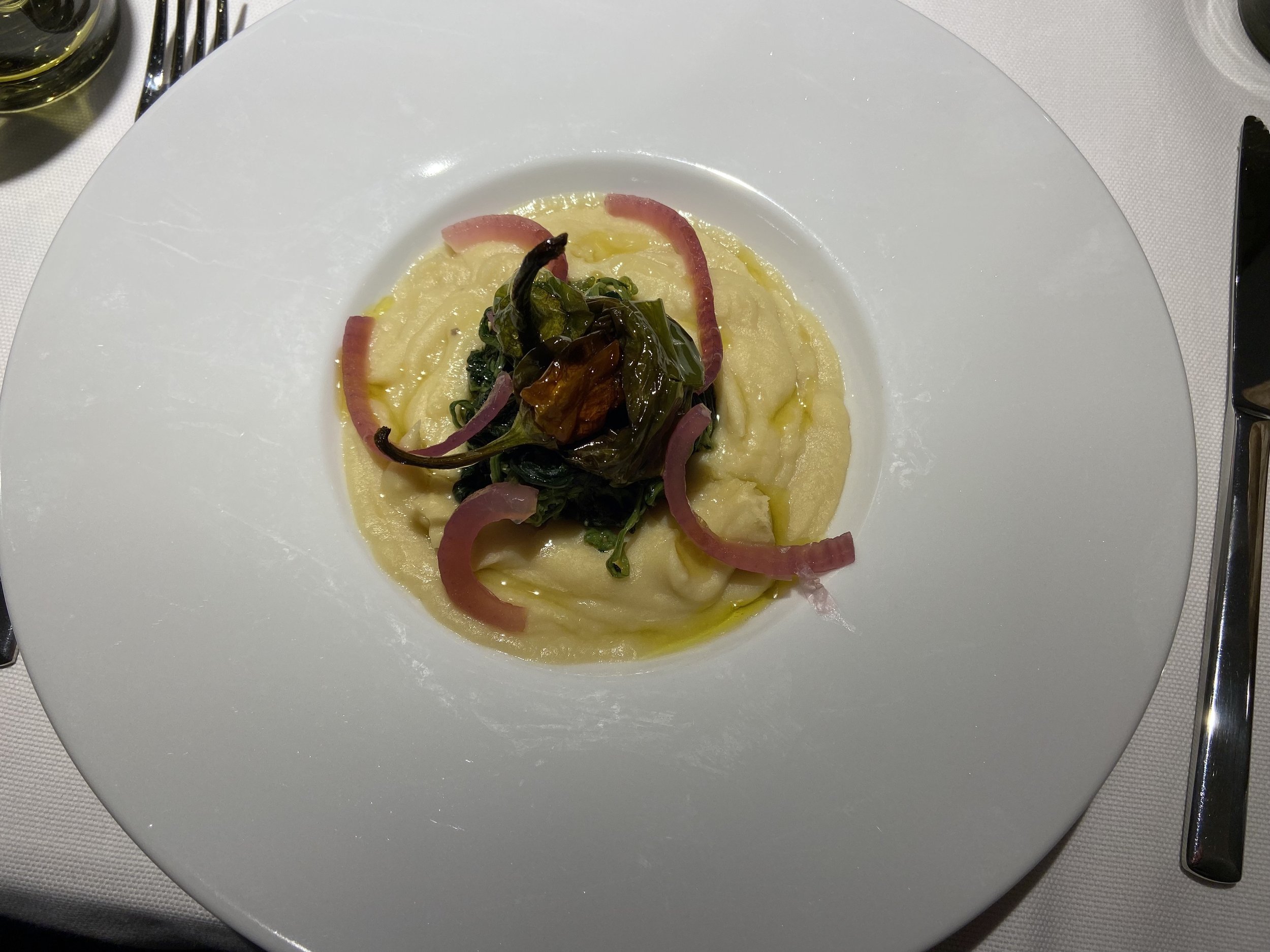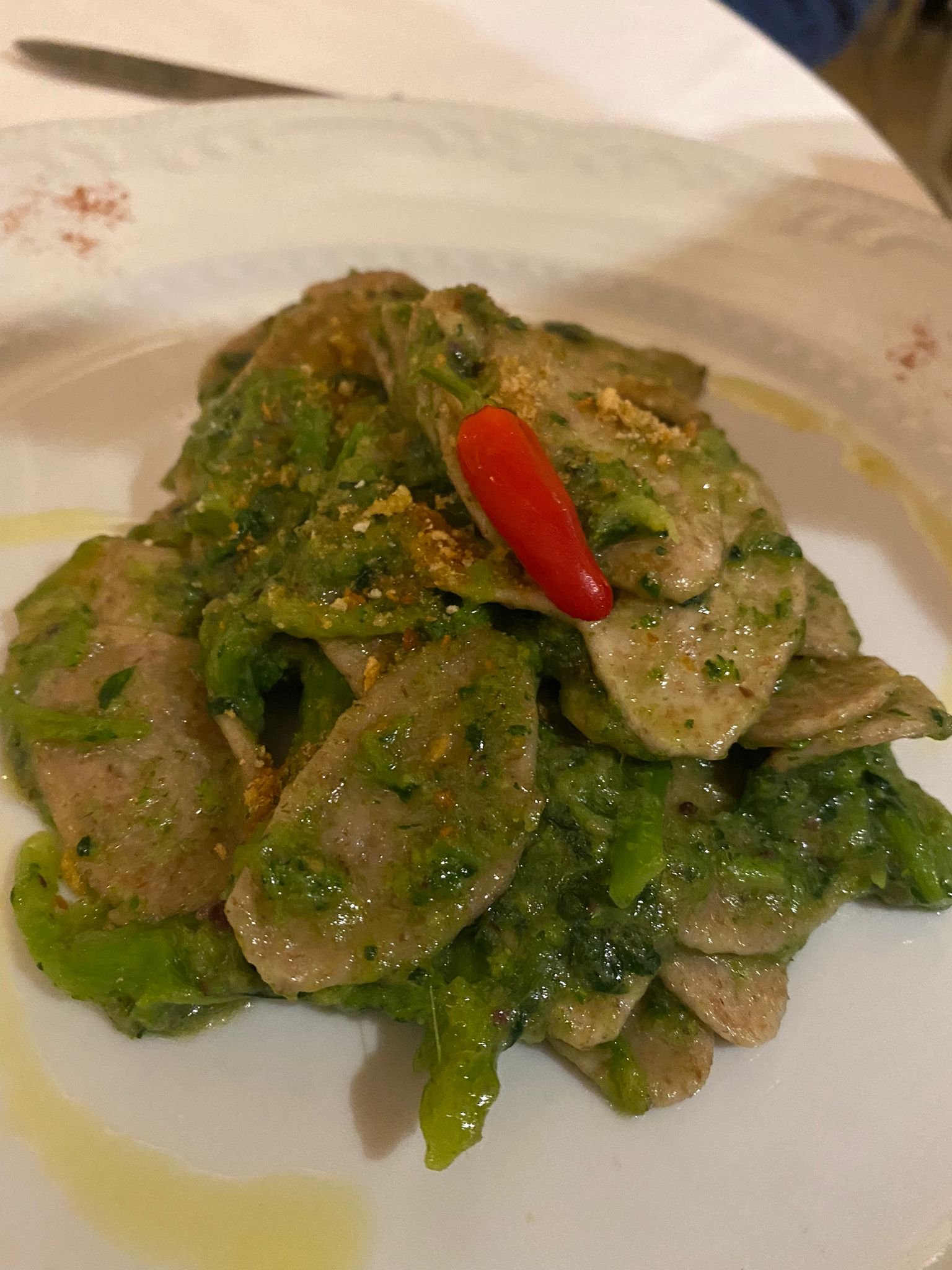Food and Wine
La Cucina Pugliese has been influenced quite profoundly by Greek culture; this is especially true of the cuisine in Salento (Cucina Salentina) which is a subset of the regional cuisine. The fave (yellow splitpea), for example, is paired with cicoria in both Puglia and Basilicata; similarly, the pureed fava bean is a mainstay on Greek menus as well. So, be sure to try fave e cicoria at one of the recommended restaurants. Hence, the cuisine is heavily influenced by the historical Magna Grecia (or greater Greek territories), but I would like to highlight a few other regional specialties.
The eminent pasta of Puglia is Orecchiette con le cime di rape (as featured at right). The traditional pasta resemble little ears, and this is literally the translation. Then, the cime di rape can be translated as broccoli rabe. Broccoli rabe looks more like a kale or chicory than the traditional broccoli florets. It is actually a part of the turnip family, and the flavor is quite different too. I love the taste because the larger dark green leaves have a slightly bitter taste, somewhat similar to kale. The traditional recipe uses breadcrumbs with topnotch olive oil and some of the pasta water. You will find variations of this dish throughout Italy as it is much beloved, but make sure to try it in the region of origin. Another classic dish is ciceri e tria (chickpeas and pasta in the local dialect). Traditionally, part of the pasta (tagliatelle) is fried to give it a crunch and added to the chickpeas; some recipes use a little broth.
Another classic treat from the region of Puglia are the taralli. These are a salty snack that I am quite addicted to. I would probably say they are my top snack food; perfect with an aperitivo or on a long car journey back from Puglia. They are essentially circular crackers and can be made salty, my favorite variety is with a little peperoncino added. You will also find them sweet, dipped in sugar. They are delicious when fresh from a bakery, particularly plump and a little cakey. See the video at right for a straightforward recipe. I have never attempted a homemade variety, but I might try my hand at some point! I cannot neglect another ‘carby’ regional delight which is the Foccaccia Barese. Perhaps when you hear ‘foccaccia’ the ‘genovese’ kind comes to mind. The Barese variety is even softer, denser, thicker. You are in for a real treat if you have not tried it!
Of course, you will find some delicious seafood in this region. Fresh fish, shellfish and polpo (octopus) in particular will be on offer, especially in the coastal towns. Ricci (sea urchin) is also popular, and you will find them splashed across tables in the fresh seafood markets as in the cover photo to this post.
The second course highlight that you should at least try ‘when in Puglia’ is cavallo ( Equine or horse meat). Often you will see Le polpette di cavallo, meat balls made with horse meat. Read more about this tradition here.
Regarding sweets from the region, you will find almond as a prominent ingredient as they are grown in abundance here and on the neighboring island of Sicily. Look out for biscotti di mandorla (almond cookies) and try an almond flavored gelato at Natale Pasticceria.
Wine
Let’s talk wine. Reds are ahead in Puglia, making up about 80% of the production, according to The Thinking Traveller and the most popular regional grapes to try are Negroamaro and Primitivo. Both described as quite ‘fruit forward’ and the primitivo is genetically similar to a zinfandel. Nero di Troia is also grape you often here cited in relation to the region, although it is becoming scarcer than in centuries past. At the time of writing this segment, I hadn’t tried it yet, but through this research I found out about the Verdeca grape used to make white wine in mostly in the Taranto and Bari provinces. It is described by the Wine Searcher website as neutral and herbal with some citrus flavors.
Update 2023: I feel like I gained a much greater appreciation and understanding of the wine culture in Puglia after a trip in the Spring of 2022. As you can read on their website, a member of the Cardone family shared a compelling narrative about how grapes grown in areas Puglia at large were often used only to send in bulk up to Northern Italy to be used by large companies such as Martini. After the 1970s, Cardone and other winemakers in Puglia started to more seriously invest in the territory and commit to making quality wines. As the Verdeca grape was mentioned above, we tasted a nice one here.
If I had to choose one winery to recommend, however, I would encourage you to seek out Masseria Croce Piccola. We found Bepi and his wonderfully intimate estate through the help of The Thinking Traveller (grazie!) The food to accompany the wine was so thoughtful, so delectable, and all of the wines I tried, I adored. The white, Mare Minu, is made from the Maresco & Minutolo grapes (other white grapes I now appreciate grown in the region); floral but with great minerality, I will want to come back to this wine. The Susumaniello grape is used to make an excellent rose and we tasted a red too. There was a fun origin story related to the grape’s name as well, that perhaps it was given by farmers yelling “su su” (up, up) to donkeys used to carry the grapes. Donkey can be translated to Somarello, appropriately, the name of the rose wine produced at Croce Piccola.
The sparkling wine also using the Maresco grape, called Marasco, made by L’Archetipo, a natural producer, is incredibly good, and we drank it at Il Cucco Enoteca in Cisternino. Unfortunately, we did not make it out to visit; however, it would be an easy stop over on the way to visit Matera (in Basilicata) and/or Altamura (another worthy city to explore in Puglia, time permitting.)




